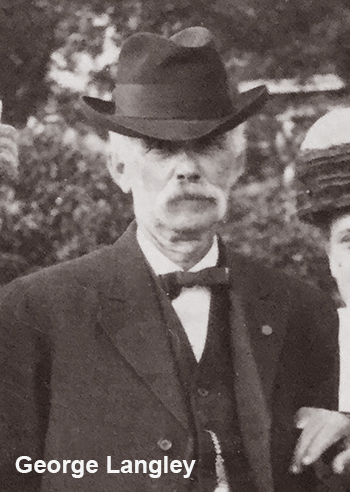George Langley
 Private George Langley was wounded on Feb. 6, 1865, at Hatcher's Run, Va., two months before being part of the final battles around Appomattox and taking the surrender of Robert E. Lee's forces.
Private George Langley was wounded on Feb. 6, 1865, at Hatcher's Run, Va., two months before being part of the final battles around Appomattox and taking the surrender of Robert E. Lee's forces.
Langley was in the 16th Michigan Infantry, Company A. He had enlisted on March 9, 1864, at Rockland, which is in the western Upper Peninsula, in Ontonagon County. He served to May 31, 1865.
Langley died on Jan. 9, 1944.
The 16th Michigan was organized from July to September 1861, and it had nearly three years of combat before Langley arrived. Two months after he began, it was in the landmark battles of the Wilderness May 5 to 7, 1864, and Spotsylvania May 8 to 12, including the Assault on the Salient May 12.
Then it was in fighting near Petersburg, Va., June 16 to 18, 1864, and the resulting siege there, which lasted until April 2, 1865.
The Battle of Hatcher's Run, also known as Dabney's Mill, Armstrong's Mill, Rowanty Creek and Vaughn Road, was one in a series of Union offensives during the siege of Petersburg, aimed at cutting off Confederate supply traffic west of that city.
At Hatcher's Run, Langley's regiment was in V Corps, led by Maj. Gen. Gouverneur K. Warren. It was in Warren's 1st Division (under Maj. Gen. Charles Griffin) and 3rd Brigade (under Brig. Gen. Alfred L. Pearson).
The 16th later was part of the Appomattox Campaign, March 28 to April 9. It was part of the fall of Petersburg April 2 and the final pursuit of Lee April 3 to 9, including at Appomattox Court House April 9, when Lee surrendered to U.S. Grant. Langley's 16th Michigan then was one of the many units taking the physical surrender of Lee and his army, which was on April 12. Confederates marched up a road flanked by Union forces.
Gen. Joshua Chamberlain, who presided over that ceremony, said: "Bayonets were affixed to muskets, arms stacked, and cartridge boxes unslung and hung upon the stacks. Then, slowly and with a reluctance that was appealingly pathetic, the torn and tattered battle flags were either leaned against the stacks or laid upon the ground. The emotion of the conquered soldiery was really sad to witness. Some of the men who had carried and followed those ragged standards, through the four long years of strife, rushed, regardless of all discipline, from the ranks, bent about their old flags, and pressed them to their lips with burning tears. …
"Nearly an entire day was necessary for that vast parade to pass. About 27,000 stands of arms were laid down, with something like a hundred battle flags; cartridges were destroyed, and the arms loaded on cars .…"
Finally, the 16th Michigan marched in the Grand Review, the massive victory parade in Washington, D.C., on May 23.
Langley and the 16th were part of the first day of the Grand Review, when Maj. Gen. George Gordon Meade, the leader at Gettysburg, led an estimated 80,000 men of Army of the Potomac from Capitol Hill down Pennsylvania Avenue.
The next day saw Gen. William Tecumseh Sherman lead the 65,000 men of the Army of the Tennessee and the Army of Georgia down the same route.
Sources:
Civil War Archive: 16th Michigan Infantry
Wikipedia: Battle of Hatcher's Run
Wikipedia: Union Forces at the Battle of Hatcher's Run
American Battlefield trust: The Last Salute of the Army of Northern Virginia
American Civil War Story: Joshua Chamberlain
National Park Service: The Final March - Grand Review of the Armies
Wikipedia: Grand Review of the Armies
Researched and submitted by Tom Mueller, PCC and Department GRO
Sons of Union Veterans of the Civil War
Department of Wisconsin

Comments to
Last Updated: 8 Dec 2022